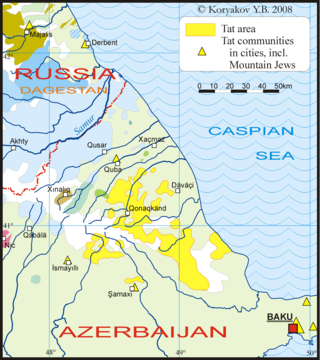| Revision as of 16:37, 16 August 2012 editGabriel Stijena (talk | contribs)65 edits (you remove information with references (vandalism by 96.255.251.165))← Previous edit |
Revision as of 17:00, 16 August 2012 edit undoKurdo777 (talk | contribs)5,050 edits Per WP:Fringe and WP:RSNext edit → |
| Line 25: |
Line 25: |
|
Excerpt: Like most Persian dialects, Tati is not very regular in its characteristic features"</ref><ref>C Kerslake, Journal of Islamic Studies (2010) 21 (1): 147-151. excerpt:"It is a comparison of the verbal systems of three varieties of Persian—standard Persian, Tat, and Tajik—in terms of the 'innovations' that the latter two have developed for expressing finer differentiations of tense, aspect and modality..." </ref><ref>Borjian, Habib, "Tabari Language Materials from Il'ya Berezin's Recherches sur les dialectes persans", Iran and the Caucasus, Volume 10, Number 2, 2006 , pp. 243-258(16). Excerpt:"It embraces Gilani, Ta- lysh, Tabari, Kurdish, Gabri, and the Tati Persian of the Caucasus, all but the last belonging to the north-western group of Iranian language."</ref> spoken by the ] in ] and ]. According to the ], it is spoken by 18,000 people in Azerbaijan, 8,000 in ], and 2,300 in Russia.<ref name="Ethnologue"></ref> Its written form is related to Middle Persian ]. There is also a ] called ] that is related to the Tat language. |
|
Excerpt: Like most Persian dialects, Tati is not very regular in its characteristic features"</ref><ref>C Kerslake, Journal of Islamic Studies (2010) 21 (1): 147-151. excerpt:"It is a comparison of the verbal systems of three varieties of Persian—standard Persian, Tat, and Tajik—in terms of the 'innovations' that the latter two have developed for expressing finer differentiations of tense, aspect and modality..." </ref><ref>Borjian, Habib, "Tabari Language Materials from Il'ya Berezin's Recherches sur les dialectes persans", Iran and the Caucasus, Volume 10, Number 2, 2006 , pp. 243-258(16). Excerpt:"It embraces Gilani, Ta- lysh, Tabari, Kurdish, Gabri, and the Tati Persian of the Caucasus, all but the last belonging to the north-western group of Iranian language."</ref> spoken by the ] in ] and ]. According to the ], it is spoken by 18,000 people in Azerbaijan, 8,000 in ], and 2,300 in Russia.<ref name="Ethnologue"></ref> Its written form is related to Middle Persian ]. There is also a ] called ] that is related to the Tat language. |
|
|
|
|
|
] mentions in the first edition of ] that like most Persian dialects, Tati is not very regular in its characteristics, and occupies a position between modern Persian and the Caspian dialects.<ref name="Minorsky">V. Minorsky, "Tat" in M. Th. Houtsma et al., eds., The Encyclopædia of Islam: A Dictionary of the Geography, Ethnography and Biography of the Muhammadan Peoples, 4 vols. and Suppl., Leiden: Late E.J. Brill and London: Luzac, 1913–38. Excerpt: Like most Persian dialects, Tati is not very regular in its characteristic features"</ref> According to him, The Great Russian Encyclopedia of 1901 gives the number of Tati speakers in 1901 as 135,000.<ref name="Minorsky"/> In the 1930s, Minorsky estimated the number of Tati speakers to be 90,000 and the decrease to be the result of gradual Turkicization.<ref name="Minorsky"/> The Tats of the Caucasus speak a Persian language, but they are assumed to be definitely Turks, since they are direct descendents of ] ] who were of Jewish faith as they are today. The Khazars adopted the Persian language and abandoned Turkish as their common language.<ref> by Dr. Kaveh Farrokh, </ref> |
|
] mentions in the first edition of ] that like most Persian dialects, Tati is not very regular in its characteristics, and occupies a position between modern Persian and the Caspian dialects.<ref name="Minorsky">V. Minorsky, "Tat" in M. Th. Houtsma et al., eds., The Encyclopædia of Islam: A Dictionary of the Geography, Ethnography and Biography of the Muhammadan Peoples, 4 vols. and Suppl., Leiden: Late E.J. Brill and London: Luzac, 1913–38. Excerpt: Like most Persian dialects, Tati is not very regular in its characteristic features"</ref> According to him, The Great Russian Encyclopedia of 1901 gives the number of Tati speakers in 1901 as 135,000.<ref name="Minorsky"/> In the 1930s, Minorsky estimated the number of Tati speakers to be 90,000 and the decrease to be the result of gradual Turkicization.<ref name="Minorsky"/> |
|
|
|
|
|
Tat is ],<ref></ref><ref name="futtattal"></ref> classified as "severely endangered" by ]'s ].<ref></ref> <!--UNESCO Endangered Language Criteria: 1. Vulnerable, 2. Definitely Endangered, 3. Severely Endangered, 4. Critically Endangered, 5. Extinct--> |
|
Tat is ],<ref></ref><ref name="futtattal"></ref> classified as "severely endangered" by ]'s ].<ref></ref> <!--UNESCO Endangered Language Criteria: 1. Vulnerable, 2. Definitely Endangered, 3. Severely Endangered, 4. Critically Endangered, 5. Extinct--> |
